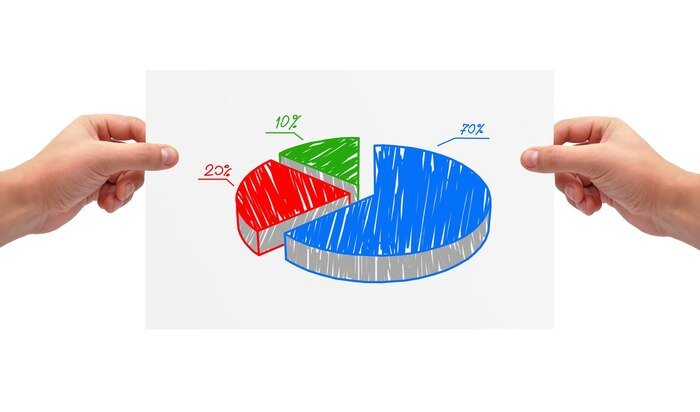How to conduct competitor analysis in e-commerce: methods and tools
-
Sergey Berezin
Copywriter Elbuz
How to beat the competition and become a successful player in the e-commerce field? This is the question that many entrepreneurs ask themselves when starting to grow their online business. And we are here to help you! The secret of success lies in a conscious analysis of competitors - those who have already advanced far along this business path. Are you ready to take on the challenge? Let's figure out together how to understand your market, uncover your competitors' weaknesses and turn them into advantages. Welcome to the world of e-commerce competitor analysis! 🔥

Setting goals
Competitor analysis in e-commerce is a powerful tool for business, but it is not the end goal in itself. It is just a tool that you must use to achieve certain goals. Setting goals is an important step in the competitor analysis process. The detailed analysis itself will allow you to understand the market and make informed decisions to develop your business.
Why analyze competitors?
Before you begin your competitor analysis, you should ask yourself, “What is the purpose of my analysis?” The answer to this question will determine your next steps. For example, you may want to use the information gained from the analysis to improve your unique selling proposition and increase sales.
What questions should you ask?
So, when researching competitors, you need to ask the following questions:
- Who are the leaders in your online store niche?
- What websites do they have?
- What is their pricing policy and product range?
- What makes their selling proposition special?
- What sales channels do they use?
- What marketing activities are they doing?

Set your goals and divide them into points
After that Once you have asked yourself questions, determine your own goals and write them down point by point. There may be a different number of points, but you should not make them too detailed. These will be your kind of checkpoints that you must go through during the analysis, in the process.
Example goal setting:
- Research the three most successful online stores in my trading niche.
- Identify the key features of their sites and user experience.
- Study the pricing policy and assortment of competitors.
- Research sales opportunities and find unique opportunities for my business.
- Analyze sales channels and marketing activities of competitors.
Useful information when performing competitive analysis
When performing competitive analysis, collect the following information:
- Data about the leaders of your niche for an online store, their websites and methods of promotion.
- Identify the key elements of their business that attract customers.
- Compare prices and product ranges of your competitors.
- Explore the features and benefits of their sales offerings.
- Evaluate the effectiveness of their marketing activities and advertising sales channels.
Don't forget! Your final decision should be based on a combination of the data collected during your competitor analysis and your own analytical assessment of the situation.

Helpful tips and best practices
When conducting competitor analysis, consider the following guidelines:
- Be purposeful and systematic in following your plan for goal setting and analysis points.
- Don't neglect researching the small details: they can be key to the success of your business.
- Consider the trends and changes in your online store niche to stay on the cutting edge.
- Use your findings to strategize and improve your unique selling proposition.
- Don't stop there - regularly update and analyze information about your competitors!
Now that you know how to set goals and effectively analyze competitors in e-commerce, you are ready to begin this important step in growing your business.
Tip : If you want to know more about choosing a niche for an online store, we recommend reading the article " How to choose a niche for an online store: 5 win-win strategies". The article provides additional useful tips and ideas for competitor analysis!
🔥 Goal Setting Review: What's Helpful and What's Not?
| What's useful ✅ | What to avoid ⛔ |
|---|---|
| Ask yourself what goal we are pursuing when analyzing competitors. | Limit your goals to analysis only. |
| Select points for analytical research. | Make points too detailed. |
| Conduct an analysis of leaders in your niche. | Limit yourself to only one source of information. |
| Collect information about prices, assortment and marketing activities of competitors. | Forgetting to update information and analyze changes in your niche. |
| Use the data obtained to develop a strategy for growing your business. | Stop there. |
Make informed and informed decisions based on competitor analysis, continue to develop your e-commerce business and success will follow!

Step 1: Analysis of market leaders and identification of competitors
In the world of Ukrainian e-commerce, there are generally recognized leaders, such as Prom.ua, which are beyond the reach of ordinary online stores. However, to make informed business decisions and understand market trends, competitor analysis is essential for everyone. Correctly identifying competitors will allow you to focus on your key tasks.
Regardless of the size or specificity of your niche, there are leaders who represent your true competitors. They are developing successfully and deserve attention. Today we will talk about methods for finding leaders in your industry and analyzing their competitive activity.

Search for leaders and assess their competitiveness
The first step in analyzing competitors in e-commerce is to identify the leading players in the market. To start, pay attention to those who appear on the first page of Google search results. You need to analyze not only contextual advertising, but the real leaders in your niche.
Start with general queries. For example, you can use the keyword "online paint store." The search results will show you the top players who are on the first page of Google results. More often than not, on the first page you will find real market leaders who pay great attention to SEO.
The next step is to explore more specific queries related to the products or services you offer. For example, if you sell facade paint, study search results for queries like “buy facade paint.” In this case, the top search results will most likely be occupied by marketplaces that are of no interest to you. On the first pages there will definitely be one of the leaders in your product segment, whom you have already identified as competitors at the previous stage.
Competitor analysis tools
Basic tools that will help you analyze competitors in e-commerce in more detail:
- SEMrush - a popular tool that provides data on positions, organic traffic, search volume and other factors that will help you understand your competitors' strategies.
- SimilarWeb - allows you to estimate the overall traffic to websites in different countries and in different industries.
- Ahrefs - helps you research incoming links from competitors, estimate the rate of traffic growth and other important parameters for analysis.
- Keyword Planner is a tool from Google Ads that will help you identify the keywords your competitors are targeting.
Example of successful analysis and application of results
Let's say you sell cosmetics and want to stand out market. After conducting a competitor analysis using the tools described, you found out that your niche is represented by large players with a large marketing budget. You need to find your “narrow” niche.
You've determined that few people in your niche actively use social media for promotion. At the same time, the analysis showed that Instagram and YouTube are popular platforms among your target audience. With the help of social networks you can stand out in the market and attract new customers!

🔥 Review of analysis of market leaders: their actions, goals
| Task 📋 | Actions ✅ | Results ⚠️ |
|---|---|---|
| Identify Market Leaders | Conduct general searches on Google. | Identify the leading players in your niche. |
| Sources and Analysis Methods | Use tools like SEMrush, SimilarWeb, Ahrefs, and Keyword Planner. | Get complete information about your niche and competitive activity. |
| Application of results | Determine your uniqueness and advantages over competitors. Develop a social media promotion strategy. | Stand out in the market and attract the attention of new customers. |
Conclusions: the benefits of analyzing market leaders
Competitor analysis in e-commerce is an integral part development of your business. It will help you understand the market, evaluate your advantages and disadvantages, stand out among competitors and attract new customers.
Use the methods and tools described to conduct a comprehensive, detailed analysis and identify your true competitors! Remember to adapt your strategy based on your analysis and constantly monitor changes in your niche.

Step 2: Evaluate competitors' online store sites
After compiling a list of your e-commerce competitors, you can begin a detailed analysis of their sites. In this step, we will look at how to evaluate online shopping sites in order to identify their advantages and disadvantages that may affect your development strategy.
Evaluate website design
The first impression that a website leaves on a visitor often plays an important role in the decision to make a purchase. When examining competitors' websites, pay attention to their design. What colors, banners and fonts are used? Do they fit together harmoniously? These elements influence the perception of the brand and help create a unique style and atmosphere on the site.
Study navigation and usability
Easy navigation and usability play an important role in how easy and pleasant it is for customers to use an online store website. Evaluate how well the navigation on your competitors’ websites is built. Is it easy to find the information and products you need there? Check how the search on the site works and how accurately it finds the desired results. Please note that there are convenient filters in the product catalog, such as price, brands, sizes, etc. Their correct configuration and operation help the buyer quickly and easily find what he needs.
Analyze the site structure
The structure of an online store site is also of great importance. The division of products into categories and subcategories should be logical and intuitive for potential buyers. Evaluate how well your competitors’ website structure is structured. You may find interesting ideas and be able to improve your own structure.

Pay attention to product cards
Product cards are pages with detailed information about a product . Examine product cards on competitors' websites and pay attention to what information about the product they contain and what elements they consist of. Browse through what interests you - this can be a good way to improve your product cards. For example, find out what a good product card should be like and what elements it should contain.
Check out the mobile version of the site
With the increasing number of users using mobile devices, the mobile version of the site is becoming increasingly important. Evaluate how well the online store website is adapted for use on mobile devices. It should be convenient for the user to view and purchase products using a smartphone or tablet.
Find out how quickly a website loads
Website performance is also very important for user satisfaction. Be sure to check your competitor's site loading speed and Google PageSpeed Insights score. If your site is slow, it can turn off visitors and lead to loss of customers.
Additional content on the site
Additional content, such as an online store blog or other useful information, can help attract and interest visitors. Research the availability of additional content on competitors' sites and determine if there is anything you can use to improve your own site and attract even more customers.
🔥 Review of evaluation of online shopping sites
In the table below we will summarize what needs to be assessed when analyzing competitors’ online store sites and determine which elements are the most useful.
| Item ✅ | What to evaluate ❓ | Usefulness ⚠️ |
|---|---|---|
| Design | Color scheme, use of banners, font and overall aesthetic | ✔️ |
| Navigation and usability | Ease of search information and products, search functionality and the presence of convenient filters | ✔️ |
| Site structure | Logical and intuitive division of products into categories and subcategories | ✔️ |
| Product cards | Complex information and elements that should be contained on product card pages | ✔️ |
| Mobile website version | Website adaptability for use on mobile devices | ✔️ |
| Website loading speed | Time it takes a website to load and its Google PageSpeed Insights score | ✔️ |
| Additional content | The presence of a blog or other useful information on the site that may be of interest to visitors | ✔️ |
Conclusions: the benefits of assessing online store sites
Use this assessment of your competitors to draw up a strategy for the development of your online store store. Highlight areas where you can improve yourself and create an action plan to achieve success!
The next step towards analyzing competitors in e-commerce is studying marketing strategies. We'll look at what your competitors are doing to attract customers and how you can apply this information to grow your own business. To be continued...
Note: Learn more about competitive analysis best practices in our article here.
Expert comment: "Assessing competitors' websites is an important step in market analysis. Remember ": your business development should be based on a thorough study of competitors and analysis of their websites! This will help you determine what is already working for other players in the market and where you can stand out with your own advantages." - Johan Vann, e-commerce expert at Sun Chemical, Netherlands
Step 3: Study the pricing policy and assortment of competitors
In this section, we will look at steps that will help you analyze the pricing policy and assortment of competitors in e-commerce. Price plays a crucial role in the purchasing decision, so it is important to have competitive prices.
Studying the pricing policy
The first step in analyzing competitors is studying their pricing policy. Let's figure out what price other online stores have set for the goods you sell. If you notice a significantly lower price from competitors, it's worth finding out why.

Finding a new supplier
Perhaps you should be looking for a new supplier for your online store . Sometimes the reason competitors have low prices is because they work with cheaper suppliers. Expand your network of suppliers and find those who can offer you more favorable terms of cooperation.
Operating Expenses and Margins
Another important aspect of your pricing strategy is your operating expenses, which can impact your product margins. Review your expenses to understand how they affect the cost of goods. For example, perhaps you spend too much on storing or packaging goods. Reducing operating costs can help set more competitive prices.

Emphasizing low prices in marketing activities
If your price, on the contrary, is lower than competitors, then this can become your competitive advantage and it is worth emphasizing this in your marketing. Pay attention to your advantages and use this data in your advertising campaign.
Studying the assortment
Now let's move on to studying the assortment of your competitor. Let's find out what variety of products your competitors offer and how this assortment attracts potential buyers.
How to attract buyers?
If your competitor's product lines are different from yours, that's okay. You need to understand how your product range can attract customers. Maybe your products are of higher quality or are imported products that are more unique than your competitors. Highlight these features of your range in your marketing materials.
Conclusions: the benefits of studying the pricing policies and assortment of competitors
Directly studying the pricing policies and assortment of competitors will help you better understand the market and make informed decisions to develop your business. Keep in mind that competitors are constantly changing their strategies, so regularly updating your analysis is a key factor in the success of your e-commerce business!
Note: To learn more about blogging for an online store, check out our article on online store blog. Learn useful tips and best practices for creating and successfully promoting a blog on your online store!

Step 4: Walking the path client
Let no one know about you! You are new to e-commerce, you have just launched your new online store and want to understand what steps to take to compete with other players in the market.
In this step, we'll look at methods for learning about your competitor through customer experience. This is a great way to understand how online stores that compete with you treat customers. During the research process, you will be able to see their strengths and weaknesses, which will help you develop your business based on best practices and unique solutions.
1. Buy products from a competitor
One of the most effective ways to study your competitor is to use their services. Select several online stores that are competitors in your business segment and make several purchases from them. In this case, you will be able to evaluate the quality of service, delivery speed, and also find out how the competitor communicates with its customers.
Also, be an attentive and appreciative customer. Check not only the quality of the goods, but also all the details of the service. Ask questions to the manager, pay attention to how promptly and fully they respond. Analyze how employees pay attention to your requests and problems, and how they respond and effectively solve them.
2. Follow the path of an ordinary buyer
Your goal is to become an ordinary online buyer your competitor's store. Be assertive, be picky, and ask a lot of questions. Try to evaluate your overall customer base, product selection, level of service and find differences from your business.
When choosing products, check how convenient the product selection and ordering service is. Evaluate what payment methods your competitor offers and find out how the store handles product delivery issues. It is important to pay close attention to every step of the purchasing process and pay attention to details.
3. Study customer reviews
To get the most information about your competitor, pay attention to customer reviews. Read reviews of competitive online stores from other customers. What is praised and what is criticized? What problems are emerging? Pay attention to such aspects as speed and quality of service, options for returning goods, money, loyalty policy and pricing.
Customer reviews provide the most objective insight into your competitors. Write down any shortcomings that customers note. This will help you understand where you can improve your online store, as well as identify areas where you already excel.
4. Qualitative Analysis and Comparison
Compare your experiences with competitors to reviews from other customers. This will help you understand how objective your overall conclusions are. Make a list of the pros and cons of each competitor, and evaluate the disadvantages that customers have mentioned.
Use the data obtained to develop your own development strategy. Separate your competitors' best practices that can benefit your business as well. Use negative reviews as well, with caution - your online store may have its own characteristics and not all competitors’ shortcomings apply specifically to your situation.
5. Overall assessment, conclusions
Competitor analysis in e-commerce is complex and an important process. Competitors can be your biggest adversaries, but they can also be a source of inspiration and improvement for your business. The key aspects of analysis are quality data, objectivity and clear, concrete conclusions.
By doing proper e-commerce competitor analysis, you will have a better understanding of the market. This makes it possible to make informed decisions in favor of developing your business. So start studying your competitors, use the knowledge and insights you gain to your advantage!
Important to remember! Competitor analysis is only one aspect of the success of your online store. Don't forget about creating a valuable, unique product line, providing high-quality customer service, and building and strengthening the brand of your business.
We also suggest reading the following interesting articles on our website:
- How to find a supplier of goods for an online store - practical advice on finding and choosing a reliable supplier of goods for your online store.
Use all the examples and don't be afraid to analyze your competitors: this will help you surpass them and achieve great success in e-commerce!
Step 5: Analysis of competitors' USP
In this section, we'll look at how to conduct research on your competitors' unique selling propositions (USPs). Every online store strives to come up with something that will help it stand out from others and become more attractive in the eyes of customers. By learning what your competitors are betting on, you can find ways to respond back and attract even more customers.
1. Evaluate Competitors' Unique Offerings
Popular online stores always offer something unique that helps them attract customers and use it as an advantage. This could include free shipping, a lifetime product warranty, or special return policies. Analyze what unique selling propositions your competitors are using and how attractive they are from a buyer's point of view.
- For example: One of the USPs could be “Free delivery on orders over 4000 UAH ". This offer attracts customers and encourages them to buy more items to get free shipping.
2. Don't copy, but improve
Once you've assessed your competitors' unique offerings, don't just copy them. Being secondary always leads to losing the fight for clients. Instead, ask yourself, “How can we respond to these suggestions and offer something better?” The store minimizes any risks when delivering goods - this is a great USP that demonstrates care for customers and increases trust in your store!
- For example: Instead of simply offering free shipping, you can offer "Free and Express Shipping" within 24 hours for orders over 3,000 hryvnia." Such an offer will be more attractive to customers, since it is not only free delivery, but also quick receipt of goods, reducing the total cost of goods and minimizing the risks associated with delivery.

3. Pay attention to detail
Don't forget that details can play an important role in a buyer's decision making. Clients often pay attention to small nuances that help them make a more informed and final choice. Think about possible details that can help attract customers and use them to your advantage.
- For example: You can enhance your free and express shipping offer by adding "free packaging gift and a personalized card upon delivery." These details will make customers feel that their order has been taken care of and will enhance their positive shopping experience. As a creative idea: before sending the goods, the operator asks the buyer whether a greeting card is needed in connection with any special event, and for whom.
4. Use analytical tools
For a deeper analysis of competitors' USPs in e-commerce, you can use various analytical tools. They can help you gain insight into which competitors' offerings are in high demand and what attracts buyers.
Examples of analytical tools
- SEMrush, Ahrefs, SimilarWeb. Using all these tools, you can get data on the popularity of your competitor's sales offers, their effectiveness and, perhaps, find new ideas for your own business!

🔥 Review: Dos and Don'ts of analysis of competitors' USPs?
| What to do ✅ | What not to do ⛔ |
|---|---|
| Study competitors' unique selling propositions | Copy competitors' offers without improvement |
| Analyze the attractiveness and effectiveness of competitors' USPs from the point of view of customers | Ignore the opinions and preferences of customers |
| Create your own unique offers, improving those already used by competitors | Remain passive and do not offer anything new |
| Consider details that may be attractive to buyers | Ignore the importance of details and small nuances |
| Use analytical tools to gain additional data and ideas | Limit yourself to your own assumptions and ideas |
| Analyze carefully results and tailor your offerings to meet customer needs | Assume that competitors' offerings are the only ones necessary to attract customers |
| Strive to offer more attractive conditions, taking into account the opinions and preferences of customers | Thoughtlessly change your USP, ignoring feedback from customers |
Conclusion: Benefits of Analyzing Competitors' USP
Identifying and leveraging your competitors' unique selling propositions plays an important role in the success of your online store. Conducting the necessary analysis will allow you to better understand the market and make informed decisions to grow your business.
Now that you know the basics of competitor USP analysis, you can start researching using the steps above. Remember: a unique and attractive sales offer should attract even more customers and ensure the stable and successful development of your e-commerce business!
Step 6: Study Competitors' Sales Channels
See if your competitors use any sales channels other than the website
All the previous steps helped us obtain information about prices, product range and promotions of competitors. Equally important is the study of additional sales channels of our competitors. Indeed, today the variety of sales channels in e-commerce has become very wide! From marketplaces to social networks, all of these tools can effectively complement your website and attract additional new customers.
Why is it important to study your competitors' sales channels?
Studying our competitors' sales channels will help us better understand how broad an audience our competitors reach. If we use only one or two sales channels, while our competitors are actively promoting and selling on five different platforms, then we risk losing them in those market categories.
In addition, studying sales channels will help us better understand where exactly we need to increase our presence. Sometimes it is not necessary to completely copy your competitors and display your products on identical platforms. We can expand our area of influence and look for new sales channels where our competitors are not yet present.
What analysis needs to be done
First, study which marketplaces your competitors use. Maybe they sell successfully on sites like AliExpress or eBay. Or, for example, marketplaces specializing in certain product categories, for example, Amazon, Ebay. See if your competitors have their own online stores on the CMS (Content management system) platforms Magento, Shopify or other popular systems.
Also pay attention to whether your competitors have landing pages that they use to promote their products. This could be a separate segment that could potentially attract new customers.
In addition, analyze whether your competitors are actively promoting on social networks. For example, they may have popular accounts on Instagram or Facebook, where they advertise their products and run interesting promotions for customers. Or perhaps they use Google Shopping to sell their products.
Use several tools for analysis
For a more complete and accurate analysis of competitors' sales channels, it is recommended to use several tools:
- Ahrefs - this service will help you find out which marketplaces your competitors are using and which ones are the most successful.
- SimilarWeb - This platform provides information about traffic on competitor sites and can also show which social platforms they are active on.
- Do a detailed analysis of the social networks where your competitors are present. Analyze the number of subscribers, activity level, and characteristics of the content they publish.
- Do some research on Google to find out which sales channels they actively advertise and promote their products on.
Practical example
An example of a company that successfully uses various sales channels is the online shoe store "Shoe Paradise". The brand has its own online store, but also actively sells on popular marketplaces such as Amazon, Ebay. In addition, Shoe Paradise is actively promoting itself on social networks, especially on Instagram, where it offers exclusive products and holds interesting giveaways for its subscribers.
🔥 Review: Exploring sales channels - what to do and not to do?
| Sales channel analysis ⚠️ | What to do ✅ | What not to do ⛔ |
|---|---|---|
| Check which marketplaces are used by competitors | Connect to popular platforms where your competitors are represented. | Ignore the most popular marketplaces. |
| Analyze the presence of selling pages from competitors | Create your own selling pages on your website. | Do not develop and optimize sales pages. |
| Evaluate the activity of competitors on social networks | Create your own accounts on popular social networks and actively promote yourself there. | Ignore social networks and potential audience. |
| Analyze search results on Google | Optimize your website to be higher than competitors in search results. | Don't care about optimizing your website and miss the chance to attract new customers. |
Conclusions: the benefits of studying sales channels
To successfully analyze competitors' sales channels, it is recommended to use tools , described above, as well as monitor the activity of competitors on the network and be ready to adapt to changes in the market environment.
Next, in the next step, we'll look at how to run giveaways on Instagram to reach a larger audience and expand your sales channels.
This sales channel analysis will allow you to better understand the market and make more informed decisions to grow your business. Use the knowledge you gain to optimize your presence and meet the needs of all your customers!
Step 7: Compare competitors' marketing activities
Once you've already learned the basics of competitive analysis in e-commerce, it's time to turn your attention to the marketing activities of your competitors. In this step, we'll look at what tactics your competitors are using and how you can use this knowledge to develop more effective strategies for promoting your online store.
Research your competitors' marketing activities
The first step in analyzing your competitors' marketing activities is to research their websites and social networks. Visit competitors' websites and review their marketing materials, such as promotions, sweepstakes, and special offers. Pay attention to what marketing techniques they use to attract customers.
Also, sign up for competitor newsletters to stay updated on their new marketing activities. This will help you quickly receive information about what promotions and special offers are being held and analyze their effectiveness.
How to use knowledge of competitors' marketing activities
Analyzing your competitors' marketing activities will help you understand what marketing techniques and strategies are successful in your niche, and how you can use them to promote your business. Don't be afraid to borrow some ideas and techniques from your competitors, especially if they've proven to work!
For example, you may see that competitors are running giveaways on Instagram and attracting a large number of customers through them. See how they organize these giveaways and you can create your own social media giveaway. Such promotions attract attention and help increase the number of subscribers and buyers.
It is also important to conduct other promotions similar to those carried out by competitors, but with better offers for customers. Think about what you can offer that is new or attractive to your audience to help you stand out from your competitors.
Benefits of Analyzing Competitors' Marketing Activities
Analyzing competitors' marketing activities gives you valuable insight into , what marketing techniques work in your niche. This knowledge will help you develop more successful strategies for promoting and attracting customers.
Advantages of analyzing competitors' marketing activities:
- Allows you to learn about the most effective marketing techniques in your niche.
- Provides an opportunity to attract more customers through the use of successful promotions and offers.
- Allows you to see the weaknesses and strengths of competitors and use this knowledge for your development.
- Enables you to create unique and compelling marketing offers for your audience.
🔥 L best practices for competitive analysis of marketing activities
To get maximum benefit from the analysis marketing activities of competitors, it is recommended:
- Study the websites and social networks of competitors to obtain information about their promotions and offers.
- Subscribe to newsletters from competitors to quickly receive information about new marketing activities.
- Analyze the effectiveness of competitors' marketing activities and learn lessons for your business.
- Adopt successful techniques and strategies from competitors, adapting them to your audience.
- Develop unique and compelling marketing propositions to differentiate yourself from competitors.
Remember! Analyzing your competitors' marketing activities should be part of your promotion strategy. Use the knowledge and experience you gain to create more effective marketing campaigns and attract even more customers.
Example. WT is running giveaways on Instagram to attract new customers. They offer the chance to win prizes and make it fun and exciting. Our online store can also hold a similar promotion, but with more attractive conditions for customers. For example, we may offer multiple prizes and a longer promotion period to increase user engagement. This will help us attract new customers and strengthen our connection with existing audiences.
When studying your competitors' marketing activities, keep in mind the purpose of your business and your customers. When adopting and adapting your competitors' ideas, make sure they fit your brand and help you achieve your goals.

Expert opinion: "Analysis Competitors' marketing activities help you gain knowledge about the market and keep up with the times! Remember: the successful techniques of competitors are not always suitable for your business! You need to adapt them to your audience and the unique features of your online store." - Steve Pitgrof, e-commerce marketing expert at Wrigley Jr. Company, USA
You have already learned how to analyze the marketing activities of competitors and how use this knowledge to develop more effective strategies for promoting your online store.
Remember! Such analysis should become a regular practice in order to always be aware of the latest marketing trends in your niche!
🔥 Review: comparison of marketing activities - what to do and not to do?
| Do ✅ | Don't do ⛔ |
|---|---|
| Study websites and social networks of competitors | Simulate marketing activities without adaptation |
| Subscribe to competitor newsletters | Finish analysis after the first step |
| Analyze the effectiveness of competitors' marketing activities | Blindly copy all competitors |
| Adopt successful techniques and strategies, adapting them to your audience | Ignore your own uniqueness |
| Develop unique and attractive marketing offers | Neglect feedback from the audience |
Now you're ready for the next step - analyzing your competitors' positioning in search engines!

Competitor analysis results
Competitive analysis is an important tool for understanding the market situation and making informed decisions in e-commerce. After conducting a competitor analysis, it is important to take a close look at the information collected to determine how to use this data to improve the performance of your online store.
Reanalysis and Use of Data
Look at the results of your analysis and think about what you learned about your competitors. Imagine how this information will help you grow your business. Review what you've learned about competitors' strategies and highlight their strengths and weaknesses. Use this information to develop a specific action plan that will help you catch up, overtake or break away from your competitors.
Regular repetitions of analysis
Competitor analysis is a continuous process that requires constant attention! Repeat your competitor analysis regularly to monitor their actions and understand changes in the market situation. This will help you adapt to new trends, constantly improve your work and grow your business.
Competition is one of the most powerful incentives for business development. By studying and analyzing your competitors, you can identify new opportunities and improve your strategy to remain competitive and successful in the market.

Expert advice
Let's consider some useful tips from experts on analyzing competitors in e-commerce .
Analyze Competitors' Strengths and Weaknesses
When you conduct competitor analysis, pay attention to their strengths and weaknesses. Use this information to determine your competitive advantage and bring more compelling offerings to market.
Study sales and marketing strategies
Analyze your competitors' sales and marketing practices. Highlight what channels and tools they use to attract customers and increase sales. Use this knowledge to improve your own strategy.
Be on the lookout for new trends
Keep an eye on new e-commerce trends and examine how competitors are adapting to them. This will allow you to always be a leader in the market and avoid having your business eliminated.
Examples of successful competitive analysis
Let's look at some examples of successful competitive analysis in e-commerce .
Example 1: Pricing Strategy Analysis
An online retailer conducted a competitor analysis and found that its prices were significantly higher than its competitors. This analysis showed the potential loss of customers due to high prices. As a result, the company decided to increase its competitiveness by setting more competitive prices and offering special offers and discounts.
Example 2: Researching New Product Categories
Another online retailer conducted a market analysis and found that competitors had various new product categories that they did not have them. This analysis allowed them to realize that there was potential to increase the range to attract new customers and meet the needs of current customers.
🔥 Review: analysis results - what to do and not to do?
The table provides an overview of what is useful to do and what not to do when conducting competitive analysis in e-commerce:
| What to do ✅ | What to avoid ⛔ |
|---|---|
| Study competitor strategy | Ignore competitors |
| Repeat competitor analysis regularly | Do not update analysis data |
| Analyze strengths and weaknesses of competitors | Copy competitors' strategy |
| Study and adapt to new trends | Remain still and inactive |
Competitor analysis allows you to better understand the market and create an informed action plan for the development of your online store. Update your analysis regularly and make smart decisions based on your findings. Don't forget that competition is an incentive for the growth and success of your business! 🚀

"Success in e-commerce is determined not only by the quality of goods or services, but also by the ability to analyze competitors and constantly adapt to changing market demands." - E-commerce expert Vadim Tarasenko, ELBUZ company, Ukraine
Columbia Expertise
Client Description
Columbia Company - one of the e-commerce market leaders in the production and sale of sports and active clothing. They offer a wide range of products including outerwear, footwear and accessories for outdoor activities and sports.
Business Goals
The main goal of Columbia is to increase sales and strengthen its leading position in the e-commerce market. To achieve this goal, the company has the following main objectives:
- Increasing awareness of the Columbia brand among the target audience.
- Improving the user experience on the company's online store website.
- Optimization of pricing policy and product range.
- Increase customer conversion and retain existing customers.
Main problem
The main problem faced by the company " Columbia" had low customer conversion rates on their online store site. In this regard, the company decided to conduct an analysis of competitors in e-commerce to determine the reasons for low conversion and develop a strategy to improve it.
Characteristics and interests of the target audience
Columbia's target audience includes active and athletic people who value the comfort and quality of clothing for sports and outdoor activities. They are interested in fashionable and functional solutions that will help them feel better during active and extreme hikes.
Key Benefits
Columbia offers the following key benefits that may be of interest to you: potential clients:
- High-quality innovative sports and active clothing.
- Large selection of products for various sports and outdoor activities.
- Affordable prices and discount system.
- Convenient and intuitive online store with a simple ordering process.
- Lightning-fast delivery and quality customer service.
Specific results of the project
As a result of the analysis of competitors in e -commerce, Columbia identified several key aspects that contributed to low customer conversion rates on their website. Some of the major improvements implemented by the company included:
- Revising and streamlining the user interface and introducing more intuitive site navigation.
- Improving the quality of product photos and providing detailed information about each product.
- Implementation of a loyalty program for regular customers, offering them exclusive discounts and privileges.
- Expand payment and delivery options to meet different customer needs and preferences.
- Conducting marketing campaigns and promotions to increase brand awareness and attract new customers.
Thanks to these changes, Columbia has significantly improved its customer conversion rate and achieved sales growth in its online store.
🔥 Video review: Columbia sportswear and footwear store
🔥 Frequently asked questions questions on the topic: "How to analyze competitors in e-commerce?"
1. What methods can be used to analyze competitors in e-commerce?
Methods for analyzing competitors in e-commerce include searching for market leaders, assessing online store sites, studying pricing policy and assortment, following the customer journey, researching competitors’ USPs, studying sales channels , as well as comparison of marketing activities.
2. Why do you need to analyze competitors in e-commerce?
Competitor analysis allows you to better understand the market, identify your advantages and disadvantages, and make informed decisions to develop your e-commerce business.
3. How to look for market leaders and identify competitors?
To find market leaders and identify competitors in e-commerce, you can use tools and information sources such as search engines, social networks, online databases and specialized platforms.
4. How to evaluate competitors' online store sites?
Evaluating competitors' online store sites includes analysis of design, ease of navigation, functionality, content, as well as assessment of user experience and brand perception.
5. How to study the pricing policy and assortment of competitors?
Studying the pricing policy and assortment of competitors may include analysis of price ranges, special offers, discounts, as well as analysis of the range of goods or services.
6. What is the USP of competitors and how to research it?
A competitor's USP (Unique Selling Proposition) is what makes their offering unique and attractive to customers. Research of competitors' USP includes analysis of unique advantages, values, features of products or services.
7. How to study competitors' sales channels?
Studying competitors' sales channels includes analyzing their presence in online and offline channels, using social networks, marketplaces, retail outlets and other distribution channels.
8. How to compare the marketing activities of competitors?
Comparing competitors' marketing activities may include analysis of their advertising campaigns, promotions, use of social media, participation in events and other marketing channels.
9. What results can be obtained from competitor analysis?
Competitor analysis can help identify major trends and patterns in the market, identify competitors' strengths and weaknesses, identify opportunities to improve your business and develop new competitive strategies.
10. How to use the results of competitor analysis to develop your e-commerce business?
Competitor analysis results can help define business strategy, improve service or product offerings, tailor pricing policies, improve marketing and sales tactics, and develop unique positioning to attract new, delighted customers. !

Did you read to the end? You are a real expert! 🔥
Congratulations! You have just become a true pro in e-commerce competitor analysis! Thanks to this article, you have gained valuable knowledge and tools that will help you not only better understand the market, but also make informed, informed decisions to develop your business.
Now, you have everything you need to conduct a detailed analysis of the competitive landscape, highlight the strengths and weaknesses of your competitors, and create effective strategies that will help you stand out from the rest of the competition.
So don't waste time: put this knowledge into practice and achieve success in business! And remember: use our invaluable knowledge wisely and continue to improve with us!
Good luck in analyzing your competitors and reaching new heights in e-commerce! 🚀 🔥
🔥 Video review: Competitor analysis. How to do a competitive analysis - Example + Template
- Setting goals
- Step 1: Analysis of market leaders and identification of competitors
- Step 2: Evaluate competitors' online store sites
- Step 3: Study the pricing policy and assortment of competitors
- Step 4: Walking the path client
- Step 5: Analysis of competitors' USP
- Step 6: Study Competitors' Sales Channels
- Step 7: Compare competitors' marketing activities
- Competitor analysis results
- Columbia Expertise
- Video review: Columbia sportswear and footwear store
- Frequently asked questions questions on the topic: "How to analyze competitors in e-commerce?"
- Did you read to the end? You are a real expert!
- Video review: Competitor analysis. How to do a competitive analysis - Example + Template
Article Target
Provide readers with practical tools and knowledge for analyzing competitors in e-commerce
Target audience
Sales and marketing managers in e-commerce interested in the basics and methods of competitive analysis
Hashtags
Save a link to this article
Sergey Berezin
Copywriter ElbuzIn the world of virtual opportunities, I am the mastermind behind the success of online stores. Words are my tools and automation is my magic recipe. Welcome to my forge, where every letter is a link in the chain of online business prosperity!
Discussion of the topic – How to conduct competitor analysis in e-commerce: methods and tools
In this article, we will look at methods and tools for analyzing competitors in e-commerce, which will help you better understand the market and make informed decisions to develop your business.
Latest comments
1 comments
Write a comment
Your email address will not be published. Required fields are checked *






















John
For the first time I tried to analyze competitors in e-commerce. It turns out there are a bunch of methods and tools. What is your favorite method of analysis?